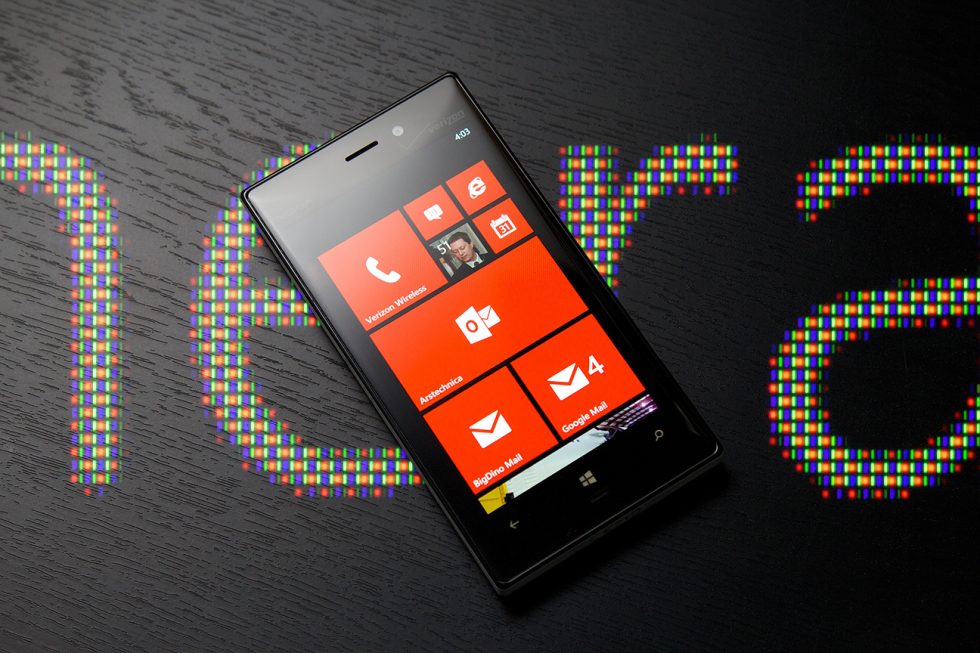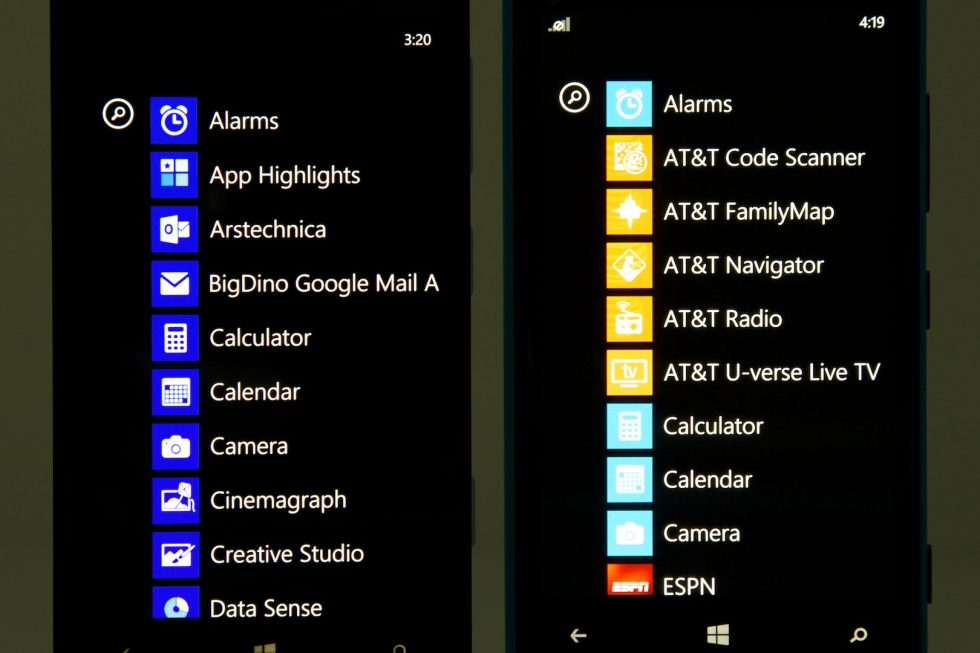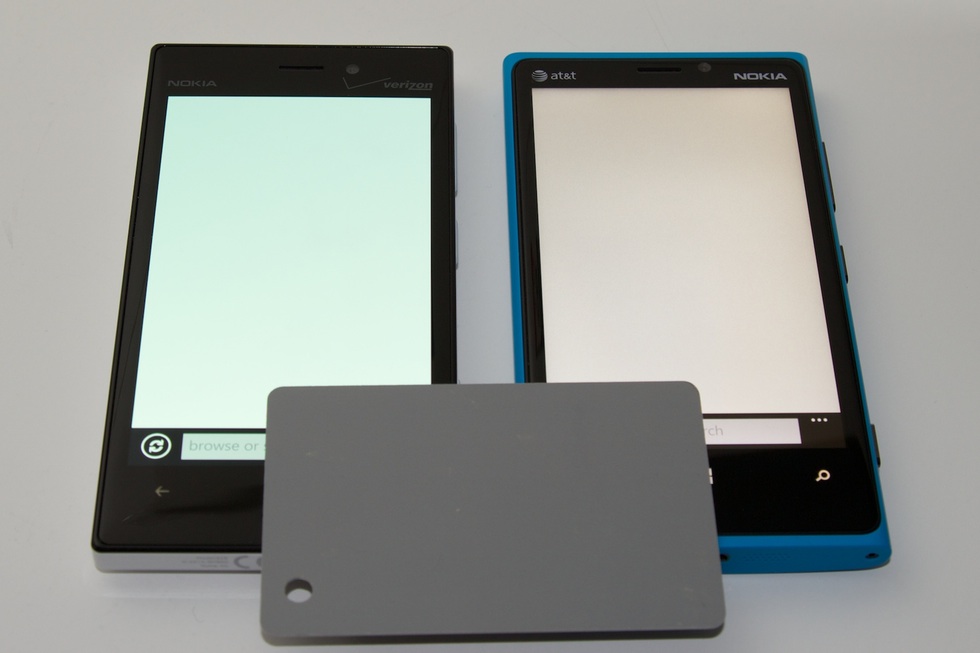
| Specs at a glance: Nokia Lumia 928 | |
|---|---|
| Screen | 768×1280 4.5" (334 ppi) AMOLED |
| OS | Windows Phone 8 (8.0.10211.204) |
| CPU | Dual core 1.5GHz Qualcomm Snapdragon S4 Plus (MSM8960) |
| RAM | 1GB |
| GPU | Qualcomm Adreno 225 |
| Storage | 32GB NAND flash, non-expandable |
| Frequencies supported | CDMA (800, 1900 MHz); GSM (850, 900, 1800, 1900 MHz); UMTS (850, 900, 1900, 2100 MHz); LTE (700, 800, 900, 1800, 2100, 2600 MHz) |
| Networking | 802.11a/b/g/n, Bluetooth 3.0, NFC, LTE |
| Ports | Micro-USB, headphones |
| Camera | 8.7MP rear camera, 1.2MP front camera |
| Size | 5.24" × 2.71" × 0.40" (133 × 68.9 × 10.1 mm) |
| Weight | 5.7 oz (162 g) |
| Battery | 2000 mAh (non-removable) |
| Starting price | $499.99 with no contract; $99.99 on-contract |
Nokia's Lumia 928 is a lightly updated version of last year's Windows Phone juggernaut, the Lumia 920. Six months after the 920's release, the 928 brings a few small improvements over the 920—the shape is a bit more squarish, it has a new Xenon flash for its camera, and it has an AMOLED screen that looks absolutely marvelous.
As with its predecessor, the Lumia 928's camera is one of its most heavily promoted features. With this in mind, Ars reporter Casey Johnston wrote a brief hands-on post with our Lumia 928 as soon as we received it from Nokia. The comments from that article brought up a lot of questions about the camera, including requests for full-resolution original images directly from the device. We've done our best to answer the call, and in the image comparisons below, we've included links to full-res versions of all the included pictures.
First things first, though. Last year in our Ultimate Guide to Smartphones feature set, we wound up preferring HTC's flagship Windows phone, the 8x, over the Lumia 920. A lot of it had to do with the fact that the 920 was just a darn big phone. The 928 is a bit taller (133 mm versus 130) but it's also a teeny bit narrower and skinnier (about 2 mm on width and about .6 mm on thickness). And the difference in size isn't nearly as apparent as the difference in shape—the 928 is a lot more squared off.
-
The Lumia 928 (left) compared to its rounder older brother, the Lumia 920 (right).Lee Hutchinson
-
The front of the Lumia 928. Below the AMOLED screen are hardware touch buttons for back, home, and search.Lee Hutchinson
-
The buttons on the right side of the Lumia 928. From top to bottom, it has a rocker-button for volume, a lock button, and a button for invoking the camera.Lee Hutchinson
-
The rear of the 928. The PureView camera is center, with the new Xenon flash just above and to the right. Speaker is at the left.Lee Hutchinson
-
The top of the Lumia 928. At center is the micro-USB connector for syncing and charging; to the left is the SIM slot and to the right is the hole for SIM removal. The 928 is sold unlocked and supports several GSM bands.Lee Hutchinson
The 928 is still big, though, and it felt quite whale-like in my pocket during the two weeks I spent using it as my daily driver. I never got used to the thing's dimensions. Even though the size of the screen drew praise from many different people—including some of the cast of Battlestar Galactica—there's no getting around the fact that it's just a large phone.
Oddly, one thing that has changed between the 920 and the 928 is the location of the micro-USB receptacle. On the 920, the plug was on the bottom. With the 928, Nokia has moved it to the top. I didn't find that I had a preference one way or the other, but the fact that they were different made it annoying to keep both phones plugged in side-by-side on my desk while comparing them. I'm also not a fan of the unlock button in the middle of the phone's right edge, and it might just be a personal failing on my part. But even after a couple of weeks of use, I still haven't quite committed a smooth pull-from-pocket-and-press-to-unlock motion to muscle memory. Every time I produce the phone, I still fumble a bit and more often than not end up pressing the volume and camera buttons on the first try.
But that screen. Oh, that lovely screen.
AMOLED all up in that
The biggest and most impressive difference between the 928 and the 920 is the 928's switch from an IPS LED display to an AMOLED display. The 920 certainly has a fine screen, but the 928's is stunning. Blacks are actual solid, inky blacks. The AMOLED's effective pixels-per-inch measures out to 332 ppi, putting it roughly on a par with an iPhone's 4/4S/5's "retina" ppi of 326. During normal use, the elements on the 928's screen appear quite sharp. There is no evidence—at least to my eyes—of fuzzy text or soft edges.

We stuck the 928 under a 100 mm macro lens to see if we could get a close-up peek at its pixel arrangement. Prior to the device's release, there was some speculation that it would use a regular RGB pixel layout. It definitively does not. The Lumia 928's AMOLED pixels are decidedly PenTile.
-
Close-up of the Lumia 928's OLED screen. Pixel layout is clearly PenTile. (Link to original image)Lee Hutchinson
-
Close-up of the Lumia 920's IPS LED screen. Pixel layout is standard red-green-blue. (Link to original image)Lee Hutchinson
-
Close-up of a "retina" resolution iPhone 4's screen at the exact same distance and magnification as the previous images. (Link to original image)Lee Hutchinson
-
Another close-up of the Lumia 928's PenTile pixels. (Link to original image)Lee Hutchinson
I vastly prefer the screen of the 928 over the 920's (still quite fine) IPS LED. Even after two weeks of usage I'm still surprised at how good it looks, and Windows Phone 8's stark contrasts play very well to the screen's strengths.
It's not totally perfect, though. At even slight angles, the screen takes on a greenish-blue cast, and it gets worse as the angle increases. Further, when scrolling through colored text on a white background—like when I'm reading an e-mail from my dear mother, with the font sent to the sky-blue Optima typeface she prefers to use—the colored portions leave faint streamers behind as the letters slide across the screen. And, unfortunately, the display is essentially invisible in direct sunlight, even at max brightness.

reader comments
207